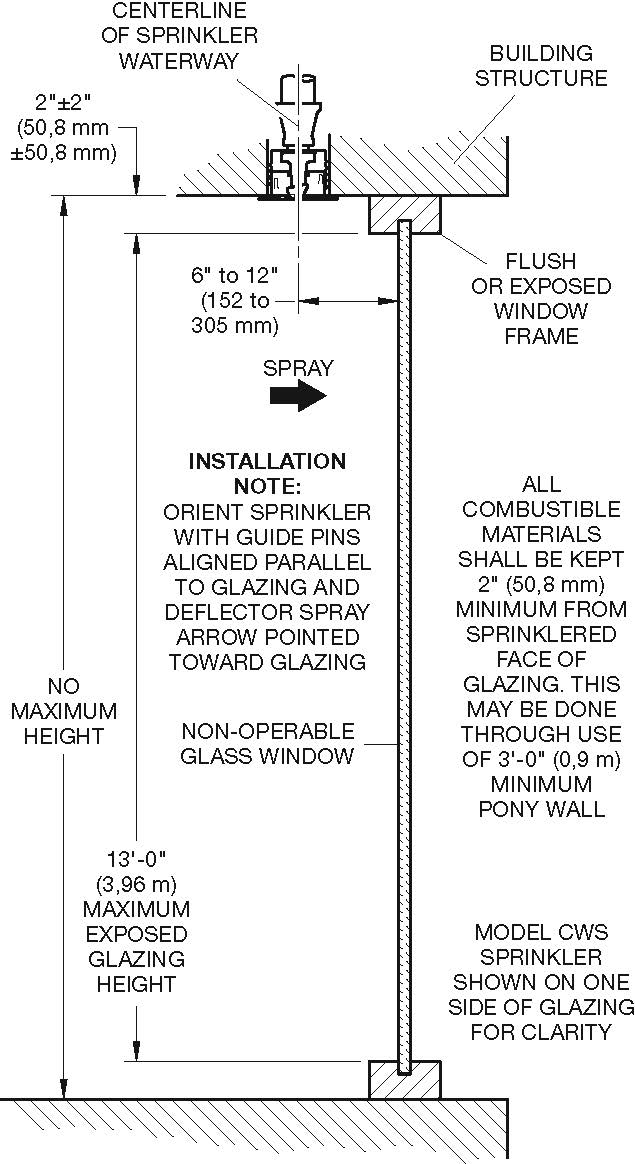Window Sprinklers as an Alternative to Fire-Rated Glass
Learning Objectives:
- Identify the characteristics of specific application window sprinklers and their ability to be a design alternative to fire-rated glass assemblies.
- Investigate the code-compliance process for window sprinklers, including the roles of the manufacturer, independent testing organizations, and design professionals.
- Assess the specific design criteria that are required in the use of window sprinklers in order to maintain the tested fire rating.
- Specify window sprinklers in a variety of buildings, and recognize the cost-saving potential in the process.
Credits:
This course is approved as a Structured Course
This course can be self-reported to the AANB, as per their CE Guidelines
Approved for structured learning
Approved for Core Learning
This course can be self-reported to the NLAA
Course may qualify for Learning Hours with NWTAA
Course eligible for OAA Learning Hours
This course is approved as a core course
This course can be self-reported for Learning Units to the Architectural Institute of British Columbia
The International Building Code (IBC), published by the International Code Council (ICC) and adopted by local authorities having jurisdiction (AHJs), has become the basis for demonstrating code compliance in almost all locations in the United States. One of the most common code requirements that architects need to address in commercial (i.e., nonresidential) buildings of all types is the fire separation requirements between spaces. For opaque partitions made of standard construction materials such as masonry or gypsum wall board over framing, there are many different options that have been tested and shown to be compliant. However, for partitions with significant areas of glass, the common assumption has been that some type of fire-rated glass is required to meet the code mandates of fire ratings (i.e., 1 hour, 1½ hour, 2 hour, etc.). In actuality, there is another option in the form of specific application sprinklers that have been designed and tested to meet fire-rating requirements for glass partitions. Referred to as window sprinklers, this alternative offers design flexibility, lighter-weight materials, and significant cost savings when compared to fire-rated glass.

Photo courtesy of Johnson Controls
Interior glazing and windows are popular in many buildings but may require a fire rating to meet code requirements. Window sprinklers and standard glass provide an alternative to fire-rated glazing.
Window Sprinklers: A Design Choice
Let’s begin with a clear understanding of what a window sprinkler is and is not. When it comes to fire-protection systems in general, the IBC devotes all of chapter 9 to the topic. In the process, it references other code documents, including the International Fire Code and publications of the National Fire Protection Association (NFPA). Specifically, the IBC refers to standard NFPA 13 regarding automatic sprinkler systems for commercial buildings (Section 903.3.1.1) by stating, “Where the provisions of this code require that a building or portion thereof be equipped throughout with an automatic sprinkler system in accordance with this section, sprinklers shall be installed throughout in accordance with NFPA 13…” There are a few special circumstances where there are exemptions and variations for residential and manufactured housing, but otherwise NFPA 13 is the basis upon which all automatic sprinkler systems are designed and judged.
While most codes and standards are very specific and sometimes seen as limiting, they usually allow some inherent flexibility for alternative safety solutions. NFPA 13 provides for such alternatives by stating, “Nothing in this standard is intended to restrict new technologies or alternate arrangements, provided the level of safety prescribed by this standard is not lowered…” This simple statement has allowed individuals and manufacturers to recognize the limitations of existing technology and develop unique products and ideas to meet the needs of current building designs and the fire-protection community. The recognition of “new technology” that may not be specifically called out in the standard is what allows manufactures to develop alternative approaches as long as they can demonstrate equivalent performance characteristics to traditional systems.
In the case of window sprinklers, they are treated under NFPA as a type of “specific application” sprinkler. That means there can be particular conditions or applications where a sprinkler designed for a certain purpose can be manufactured and tested to demonstrate how it meets the fire safety intent of the NFPA 13 standard for a specific application. In this case, the protection of non-fire-rated glass partitions is the specific application being addressed. That makes window sprinklers different from standard ceiling-mounted sprinklers that are designed and operated to protect floor and wall surfaces. Window sprinklers are typically part of an overall automatic sprinkler system design in buildings, but the mechanical design of the manufactured sprinkler head plus the location and spacing of the installed sprinkler heads are different than in the rest of the building.

Photo courtesy of Johnson Controls
Window sprinklers used with glass partitions provide design choices that architects can use to create better building designs.
The need for window sprinklers to protect room or space separations that use large glass areas has come from many architectural and interior design schemes that use such large glass walls for a variety of reasons. In some cases, it is for literal visual transparency or observation of activities. In others, it is to enhance shared daylighting and views for building occupants. For some, it is seen as a way to help encourage collaboration and cooperation among building users while still providing some appropriate separation to control sound or other needs. Regardless of the motivation, if the partition in question where the glass is being used is required to provide any form of a fire separation (i.e., along corridors, between adjacent occupancies, etc.), the default assumption has been that fire-rated glass is needed. In some cases, the area (square inches) of the glass is limited by the code, although the type of fire-rated glass can vary. Wire glass products have been available for some time but carry a particularly institutional appearance that can obscure vision, which may not match the overall design scheme. Clear laminated glass with an intumescent layer is also available but is notably more expensive than conventional glass used for interior and exterior windows. Window sprinklers offer an alternative to both of these glass choices.
It is important to note that the use of window sprinklers needs to be paired with the glass partition design. Compatible glass includes single-glazed (single-pane), double-glazed (double-pane), or insulated glass, where each individual pane is a minimum ¼ inch (6 millimeters) thick. The glass itself needs to be either heat strengthened, tempered, or stronger. Window sprinklers are also only appropriate for vertical inoperable window assemblies, and they are not intended for operable windows or glass doors—those components need their own fire rating. This is a significant point that is sometimes misunderstood by architects and authorities having jurisdiction (AHJ), as we will discuss in the next section of this article. Nonetheless, since these compatibility criteria match most common window designs, it is easy to see why the use of window sprinkler systems has been quite successfully used in a wide range of building types, including health-care settings of all types, higher education settings such as academic and lab buildings, and commercial and corporate facilities. They have even been used successfully in multifamily settings where visual connections to common areas is desired but fire separation is required.
The unique characteristic of window sprinklers that allows them to be incorporated into all of these buildings is based on several aspects of their design. First, they use a fast response operating element that quickly dispenses water for protection of the glass wall. Second, they rely on a deflector design that wets the entire window, reaching all corners and providing full coverage. From a design coordination standpoint, the piping that the window sprinkler head is connected to can be based on either a concealed or an exposed vertical and/or horizontal installation. The more common vertical sidewall approach mimics other sprinkler installations with a vertical pipe extending down through a ceiling or soffit, leaving only the sprinkler head exposed. In this case, a side deflector is used to achieve the full and fast protection. Similar to the exposed vertical sidewall, a concealed deployable vertical sidewall is also available. The concealed vertical sidewall allows for the sprinkler piping to connect to the window sprinkler above the ceiling and uses a cover plate that is available in a standard finish or custom color finish. Another option is a horizontal sidewall approach, although less commonly used. In this case, the sprinkler piping extends down below the ceiling or soffit, making a 90-degree elbow bend to run horizontally toward the window. This application uses a different sprinkler head design that is based on it pointing directly at the glass to release water for fire protection when needed.

Image courtesy of Johnson Controls
Window sprinkler systems have been tested and are available in vertical sidewall, concealed vertical sidewall and horizontal sidewall applications as shown here.
Regardless of the installation method or building type, the important thing to remember is that window sprinklers are a specific type of fire-protection equipment that are different from, although readily incorporated into, a typical automatic sprinkler system. As such, they provide a coordinated automatic fire-protection solution for the part of the building with glass partitions and where traditional sprinkler heads used in other areas of the building cannot be used as a substitute to window sprinklers.















